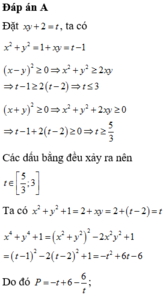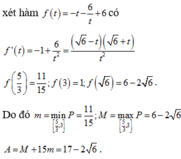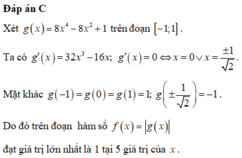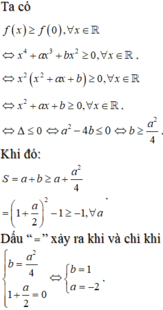Cho x+y = 1. Tìm giá trị nhỏ nhất của biểu thức M = x4 + y4.

Những câu hỏi liên quan
cho hai số x,y thỏa mãn x2 + y2 =1 + xy , gọi M và m lần lượt là giá trị lớn nhất , giá trị nhỏ nhất của P = x4 + y4 -x2y2 , tính tích Mm
\(x^2+y^2=1+xy\Rightarrow x^2+y^2-xy=1\)
Ta có: \(1+xy=x^2+y^2\ge2xy\Rightarrow xy\le1\)
\(1+xy=x^2+y^2\ge-2xy\Rightarrow xy\ge-\dfrac{1}{3}\)
\(P=\left(x^2+y^2\right)^2-x^2y^2-2x^2y^2=\left(x^2+y^2-xy\right)\left(x^2+y^2+xy\right)-2x^2y^2\)
\(=x^2+y^2+xy-2x^2y^2=-2x^2y^2+2xy+1\)
Đặt \(a=xy\Rightarrow P=f\left(a\right)=-2a^2+2a+1\)
Xét hàm \(f\left(a\right)=-2a^2+2a+1\) trên \(\left[-\dfrac{1}{3};1\right]\)
\(-\dfrac{b}{2a}=\dfrac{1}{2}\in\left[-\dfrac{1}{3};1\right]\)
\(f\left(-\dfrac{1}{3}\right)=\dfrac{1}{9}\) ; \(f\left(\dfrac{1}{2}\right)=\dfrac{3}{2}\) ; \(f\left(1\right)=1\)
\(\Rightarrow M=\dfrac{3}{2}\) ; \(m=\dfrac{1}{9}\) \(\Rightarrow Mm=\dfrac{1}{6}\)
Đúng 4
Bình luận (0)
Cho x, y là những số thực thỏa mãn
x
2
–
x
y
+
y
2
1
. Gọi M và m lần lượt là giá trị lớn nhất và giá trị nhỏ nhất của
P
x
4
+
y
4
+
1
x...
Đọc tiếp
Cho x, y là những số thực thỏa mãn x 2 – x y + y 2 = 1 . Gọi M và m lần lượt là giá trị lớn nhất và giá trị nhỏ nhất của P = x 4 + y 4 + 1 x 2 + y 2 + 1 . Giá trị của A = M + 15 m là
A. A = 17 - 2 6
B. A = 17 - 6
C. A = 17 + 6
D. A = 17 + 2 6
Cho x,y là những số thực thỏa mãn
x
2
-
x
y
+
y
2
1
. Gọi M và m lần lượt là giá trị lớn nhất và giá trị nhỏ nhất của
P
x
4
+
y
4
+
1
x
2
+
y...
Đọc tiếp
Cho x,y là những số thực thỏa mãn x 2 - x y + y 2 = 1 . Gọi M và m lần lượt là giá trị lớn nhất và giá trị nhỏ nhất của P = x 4 + y 4 + 1 x 2 + y 2 + 1 . Giá trị của A = M + 15m là
A. A = 17 - 2 6
B. A = 17 + 6
C. A = 17 + 2 6
D. A = 17 - 6
Tính giá trị biểu thức biết x+y=o
M=x4-xy3+xy3-y4-1
Ta có: \(M=x^4-xy^3+xy^3-y^4-1\)
\(=x^4-y^4-1\)
\(=\left(x^2-y^2\right)\left(x^2+y^2\right)-1\)
\(=\left(x+y\right)\left(x-y\right)\left(x^2+y^2\right)-1\)(1)
Thay x+y=0 vào biểu thức (1), ta được:
\(M=0-1=-1\)
Vậy: Khi x+y=0 thì M=-1
Đúng 3
Bình luận (0)
`M=x^4-xy^3+xy^3-y^4-1`
`=x(x^3+y^3)-y^3(x+y)-1`
`=x(x+y)(x^2-xy+y^2)-0-1`(do `x+y=0`)
`=0-0-1`
`=-1`
Đúng 1
Bình luận (0)
Tìm x
(x-5)2=(3+2x)2
27x3-54x2+36x=9
cho bt x-y=4 và xy=1 tính giá trị của các biểu thức A=x2+y2,B=x3-y3,C=x4+y4
a) \(\left(x-5\right)^2=\left(3+2x\right)^2\)
\(\Rightarrow\left(3+2x\right)^2-\left(x-5\right)^2=0\)
\(\Rightarrow\left(3+2x+x-5\right)\left(3+2x-x+5\right)=0\)
\(\Rightarrow\left(3x-2\right)\left(x+8\right)=0\)
\(\Rightarrow\left[{}\begin{matrix}3x-2=0\\x+8=0\end{matrix}\right.\) \(\Rightarrow\left[{}\begin{matrix}x=\dfrac{2}{3}\\x=-8\end{matrix}\right.\)
b) \(27x^3-54x^2+36x=9\)
\(\Rightarrow27x^3-54x^2+36x-9=0\)
\(\Rightarrow27x^3-54x^2+36x-8+8-9=0\)
\(\Rightarrow\left(3x-2\right)^3-1=0\)
\(\Rightarrow\left(3x-2-1\right)\left[\left(3x-2\right)^2+3x-2+1\right]=0\)
\(\Rightarrow\left(3x-3\right)\left[\left(3x-2\right)^2+3x-2+\dfrac{1}{4}-\dfrac{1}{4}+1\right]=0\)
\(\Rightarrow\left(3x-3\right)\left[\left(3x-2+\dfrac{1}{2}\right)^2+\dfrac{3}{4}\right]=0\)
\(\Rightarrow\left(3x-3\right)\left[\left(3x-\dfrac{3}{2}\right)^2+\dfrac{3}{4}\right]=0\left(1\right)\)
mà \(\left(3x-\dfrac{3}{2}\right)^2+\dfrac{3}{4}>0,\forall x\)
\(\left(1\right)\Rightarrow3x-3=0\Rightarrow3x=3\Rightarrow x=1\)
Đúng 2
Bình luận (0)
(\(x-5\))2 = (3 +2\(x\))2 ⇒ \(\left[{}\begin{matrix}x-5=3+2x\\x-5=-3-2x\end{matrix}\right.\) ⇒ \(\left[{}\begin{matrix}x=-8\\x=\dfrac{2}{3}\end{matrix}\right.\) vậy \(x\in\){-8; \(\dfrac{2}{3}\)}
27\(x^3\) - 54\(x^2\) + 36\(x\) = 9
27\(x^3\) - 54\(x^2\) + 36\(x\) - 8 = 1
(3\(x\) - 2)3 = 1 ⇒ 3\(x\) - 2 = 1 ⇒ \(x\) = 1
Đúng 2
Bình luận (0)
Xem thêm câu trả lời
Hàm số y = x 4 + a x 3 + b x 2 + 1 đạt giá trị nhỏ nhất tại x=0. Giá trị nhỏ nhất của biểu thức S= a + b là
A. 2
B. 0
C. -2
D. -1
cho bt x-y=4 và xy=1 tính giá trị của các biểu thức A=x2+y2,B=x3-y3,C=x4+y4
#Toán lớp 8\(\left\{{}\begin{matrix}x-y=4\\xy=1\end{matrix}\right.\\ \Leftrightarrow\left\{{}\begin{matrix}x=y+4\\y\left(y+4\right)=1\end{matrix}\right.\\ \Leftrightarrow\left\{{}\begin{matrix}x=y+4\\y^2+4y-1=0\end{matrix}\right.\\ \Leftrightarrow\left\{{}\begin{matrix}x=y+4\\\left[{}\begin{matrix}y=-2+\sqrt{5}\\y=-2-\sqrt{5}\end{matrix}\right.\end{matrix}\right.\)
Với \(y=-2+\sqrt{5}\Rightarrow x=2+\sqrt{5}\)
Với \(y=-2-\sqrt{5}\Rightarrow x=2-\sqrt{5}\)
\(\Rightarrow A=x^2+y^2=\left(-2+\sqrt{5}\right)^2+\left(2+\sqrt{5}\right)^2=\left(2-\sqrt{5}\right)^2+\left(-2-\sqrt{5}\right)^2=18\)
\(B=x^3+y^3\Rightarrow\left[{}\begin{matrix}B=\left(2+\sqrt{5}\right)^3+\left(-2+\sqrt{5}\right)^3=34\sqrt{5}\\B=\left(2-\sqrt{5}\right)^3+\left(-2-\sqrt{5}\right)^3=-34\sqrt{5}\end{matrix}\right.\)
\(\Rightarrow C=x^4+y^4=\left(-2+\sqrt{5}\right)^4+\left(2+\sqrt{5}\right)^4=\left(2-\sqrt{5}\right)^4+\left(-2-\sqrt{5}\right)^4=322\)
Đúng 1
Bình luận (0)
chứng minh giá trị biểu thức sau không phụ thuộc vào giá trị của biến:
a, A = y (x2 - y2) (x2 + y2) - y (x4 - y4)
b, B = (x - 1)3 - (x - 1) (x2 + x + 1) - 3 (1 - x) x
a) \(A=y\left(x^2-y^2\right)\left(x^2+y^2\right)-y\left(x^4-y^4\right)=y\left(x^4-y^4\right)-y\left(x^4-y^4\right)=0\)
b) \(B=\left(x-1\right)^3-\left(x-1\right)\left(x^2+x+1\right)-3\left(1-x\right)x=x^3-3x^2+3x-1-x^3-x^2-x+x^2+x+1-3x+3x^2=0\)
Đúng 1
Bình luận (0)
a: Ta có: \(A=y\left(x^2-y^2\right)\left(x^2+y^2\right)-y\left(x^4-y^4\right)\)
\(=y\left(x^4-y^4\right)-y\left(x^4-y^4\right)\)
=0
b: Ta có: \(B=\left(x-1\right)^3-\left(x-1\right)\left(x^2+x+1\right)-3x\left(1-x\right)\)
\(=x^3-3x^2+3x-1-x^3+1-3x+3x^2\)
=0
Đúng 0
Bình luận (0)
Cho x+y=a;xy=b.Tính giá trị của các biểu thức sau theo a và b:
a)x4+y4 b)x5+y5
a) Để tính giá trị của biểu thức x^4 + y^4, ta có thể sử dụng công thức Newton về tổng lũy thừa của một đa thức. Theo công thức Newton, ta có: x^4 + y^4 = (x^2 + y^2)^2 - 2x^2y^2 Từ đó, ta có thể tính giá trị của biểu thức x^4 + y^4 theo a và b: x^4 + y^4 = (a^2 - 2b)^2 - 2(a - 2b)b b) Tương tự, để tính giá trị của biểu thức x^5 + y^5, ta có thể sử dụng công thức Newton về tổng lũy thừa của một đa thức. Theo công thức Newton, ta có: x^5 + y^5 = (x + y)(x^4 - x^3y + x^2y^2 - xy^3 + y^4) Từ đó, ta có thể tính giá trị của biểu thức x^5 + y^5 theo a và b: x^5 + y^5 = (a)(a^4 - a^3b + a^2b^2 - ab^3 + b^4)
Đúng 0
Bình luận (0)
Tìm x
(x-5)^2=(3+2x)^2
27x^3-54x^2+36x=9
cho bt x-y=4 và xy=1 tính giá trị của các biểu thức A=x2+y2,B=x3-y3,C=x4+y4
(x - 5)² = (3 + 2x)²
(x - 5)² - (3 + 2x)² = 0
[(x - 5) - (3 + 2x)][(x - 5) + (3 + 2x)] = 0
(x - 5 - 3 - 2x)(x - 5 + 3 + 2x) = 0
(-x - 8)(3x - 2) = 0
-x - 8 = 0 hoặc 3x - 2 = 0
*) -x - 8 = 0
-x = 8
x = -8
*) 3x - 2 = 0
3x = 2
x = 2/3
Vậy x = -8; x = 2/3
--------------------
27x³ - 54x² + 36x = 9
27x³ - 54x² + 36x - 9 = 0
27x³ - 27x² - 27x² + 27x + 9x - 9 = 0
(27x³ - 27x²) - (27x² - 27x) + (9x - 9) = 0
27x²(x - 1) - 27x(x - 1) + 9(x - 1) = 0
(x - 1)(27x² - 27x + 9) = 0
x - 1 = 0 hoặc 27x² - 27x + 9 = 0
*) x - 1 = 0
x = 1
*) 27x² - 27x + 9 = 0
Ta có:
27x² - 27x + 9
= 27(x² - x + 1/3)
= 27(x² - 2.x.1/2 + 1/4 + 1/12)
= 27[(x - 1/2)² + 1/12] > 0 với mọi x ∈ R
⇒ 27x² - 27x + 9 = 0 (vô lí)
Vậy x = 1
Đúng 1
Bình luận (0)
A = x² + y²
= x² - 2xy + y² + 2xy
= (x - y)² + 2xy
= 4² + 2.1
= 16 + 2
= 18
B = x³ - y³
= (x - y)(x² + xy + y²)
= (x - y)(x² - 2xy + y² + xy + 2xy)
= (x - y)[(x - y)² + 3xy]
= 4.(4² + 3.1)
= 4.(16 + 3)
= 4.19
= 76
C = x⁴ + y⁴
= (x²)² + (y²)²
= (x²)² + 2x²y² + (y²)² - 2x²y²
= (x² + y²)² - 2x²y²
= (x² - 2x²y² + y² + 2x²y²)² - 2x²y²
= [(x - y)² + 2x²y²]² - 2x²y²
= (4² + 2.1²)² - 2.1²
= (16 + 2)² - 2
= 18² - 2
= 324 - 2
= 322
Đúng 1
Bình luận (0)
a: =>(2x+3)^2-(x-5)^2=0
=>(2x+3+x-5)(2x+3-x+5)=0
=>(x+8)(3x-2)=0
=>x=2/3 hoặc x=-8
b: =>27x^3-54x^2-36x-9=0
=>3x^3-6x^2-4x-1=0
=>\(x\simeq2,57\)
c: A=x^2+y^2=(x-y)^2+2xy=4^2+2=18
B=x^3-y^3=(x-y)^3+3xy(x-y)
=4^3+3*1*4
=64+12=76
C=(x^2+y^2)^2-2x^2y^2
=18^2-2*1^2=322
Đúng 0
Bình luận (0)




























